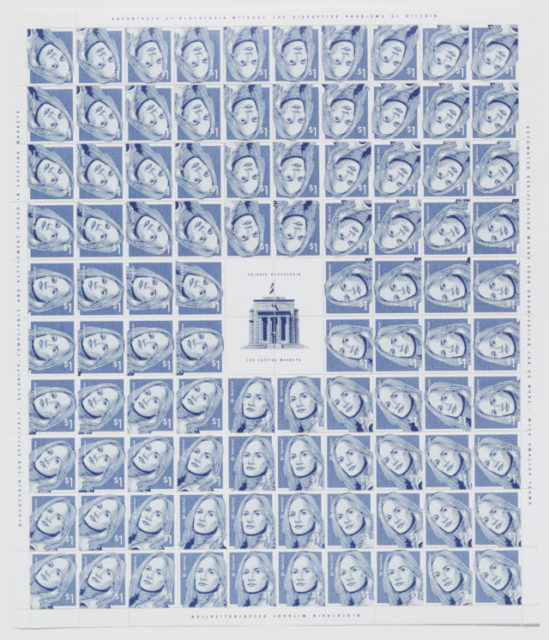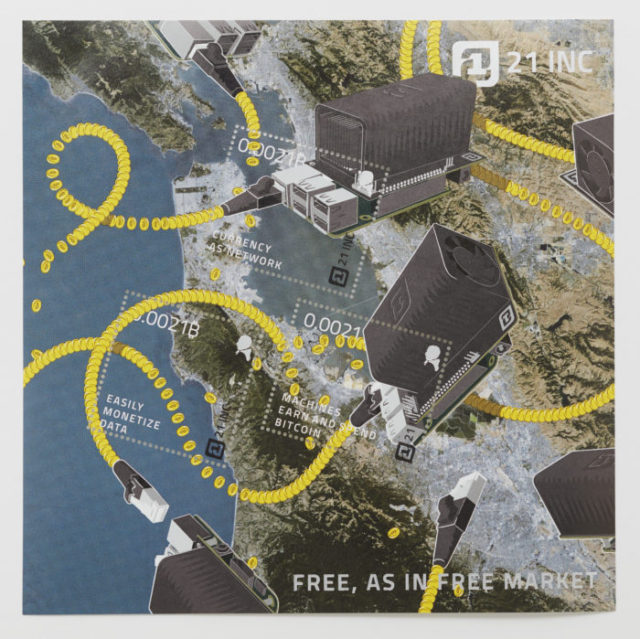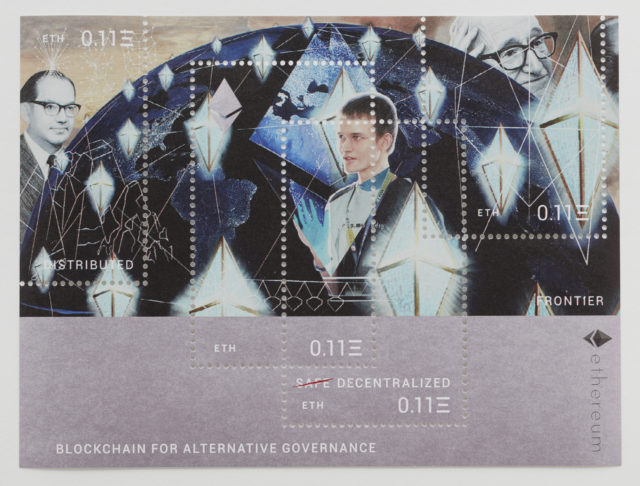It’s quite easy to miss Simon Denny’s newly installed work at Los Angeles’ Hammer Museum, running January 21 to April 23. On the exterior of the space, the viewer is confronted with four panels of mock-up screenshots from the Business Insider interface and a series of blown-up boardgames modelled on Risk is presented in a trade show format. The three versions of the game, in three information booths, are reconfigured to show the applications of blockchain technology to political-economic futures based on the visions of three real-world companies.

The initial reaction for a first time visitor to the space is that it must belong to an adjacent bank or tech company. This camouflage or appropriation is partly the success of the New-Zealand born, Berlin-based artists’ work. He deliberately uses the trade fair motif/aesthetic as a way to draw attention to contradictory impulses within the current technological moment; the way it is both an integral part of, and yet stands apart from, our everyday experience.
Yet, how disruptive is Denny’s intervention? At times it feels entirely like the very propaganda it refers to. Art historian, critic and theorist Claire Bishop draws on the Marxist philosopher Jacques Rancière to argue that the political potential of art “is not about ‘conversion,’ for this reduces the work of art to the question of propaganda. Rather, [to] draw attention to the contradictions of political discourse […] this contradiction is the core of artistic efficacy — and it is the reason why political conversion is not the primary goal of art, why artistic representations continue to have a potency that can be harnessed to disruptive ends.”

A video plays at the entrance to the space, giving a background/introduction on blockchain technology. The utopian potential of this digital distributed database is prioritised, which fits with Denny’s previous statements about making ‘fan art’ of the digital architecture, which underlies such innovations like the cryptocurrency bitcoin. Indeed, the artists’ public persona adds weight to claims of creating an aesthetic which supports digital capitalist impulses, promoting (while appropriating) its discourses and aesthetics to embed critique. This welcoming video sets a tone for the remaining installation, making libertarian claims for free markets and against centralised planning as impossible. So far so didactic.
It’s easy to make the usual critiques of such approaches. In citing or praising Milton Friedman — the American economist who promoted free-market ideology — Denny denies the well-documented history of how Friedman’s (and other economists at the School of Economics in Chicago) free market ideas (which propose a minimal role for the state in achieving economic goals) were implemented through a US government-backed coup to overthrow the socialist government Salvador Allende in Chile in 1973. There is also something more going on here than ahistoricism. Critics struggle to deal with Denny, as he doesn’t fit neatly into existing political taxonomies of contemporary art. One the one hand, there are works of a critical bent, which are interested in social and institutional critique and who gallery audiences may share a certain political proclivity. On the other hand, are those artists deemed to have fully embraced the vacuousness of the commercialised art markets (think Jeff Koons).

Denny’s work often provokes outrage, which is a pleasantly surprising and unusual reaction in a gallery. We expect to find critique embedded within the aesthetic but instead we get something much more indifferent. The level of irony feels hard to grasp in his work; is he serious or acting? In this ambiguity, we are reminded that the future of digital technology is far from settled, that even within its most ardent supporters and profiteers there is potential conflict. Capital is never homogeneous. And this is the other political potential of art, to show how, through human action, the world may be written anew. Denny, fanboy or not, gives a glimpse into the digital cultural moment as one which is emergent and contested.**
Simon Denny’s solo exhibition at Los Angeles’ Hammer Museum is running January 21 to April 23, 2017.













